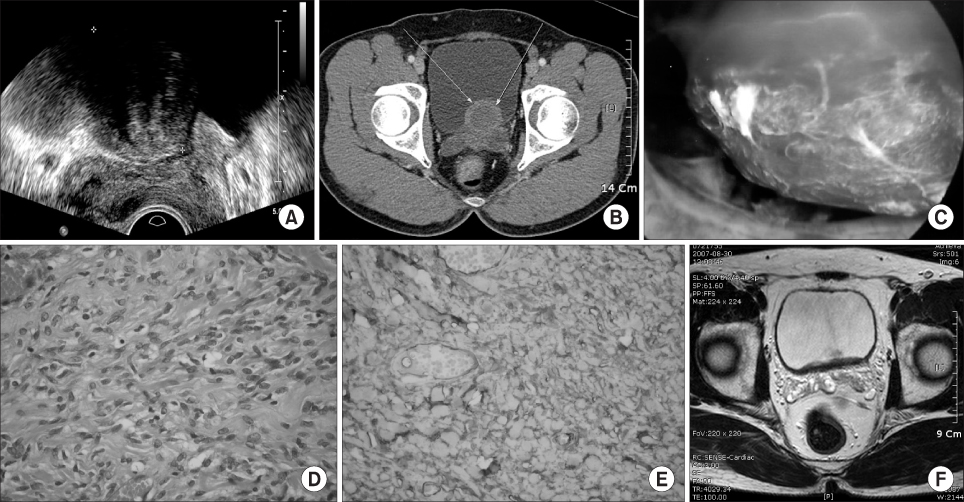Korean J Urol.
2007 Dec;48(12):1319-1321. 10.4111/kju.2007.48.12.1319.
Solitary Fibrous Tumor as Misdiagnosed as Bladder Cancer
- Affiliations
-
- 1Department of Urology, Ulsan University Hospital, University of Ulsan College of Medicine, Ulsan, Korea. rjpark@uuh.ulsan.kr
- 2Department of Pathology, Ulsan University Hospital, University of Ulsan College of Medicine, Ulsan, Korea.
- KMID: 1990158
- DOI: http://doi.org/10.4111/kju.2007.48.12.1319
Abstract
- Solitary fibrous tumor(SFT) was previously named localized fibrous mesothelioma, and this is a rare mesenchymal neoplasm that usually shows benign behavior. It is the most commonly recognized tumor of the pleura. These tumors have been recently reported to be found in unexpected locations. To the best of our knowledge, there have been only 2 reports of SFT arising from the urinary bladder in Koreans. We review this third case of SFT that was misdiagnosed as bladder cancer. This tumor was removed from a 40-year-old man who had a history of lower urinary tract symptoms.
Keyword
MeSH Terms
Figure
Cited by 1 articles
-
Myxofibrosarcoma of Bladder
So Ri Lee, Byung Joo Jeon, Ki Su Yang, In Gon Kim, Jeong Oh Lee, Bo Hyun Han
Korean J Urol. 2008;49(11):1051-1054. doi: 10.4111/kju.2008.49.11.1051.
Reference
-
1. Weiss SW, Goldblum JR. Enzinger and Weiss's soft tissue tumors. 2001. 4th ed. St. Louis: Mosby;1021–1031.2. Kim DS, Cha KB, Lee SR, Kim DJ, Cho NH, Choi YD. Solitary fibrous tumor of bladder. Korean J Urol. 2004. 45:393–395.3. Lee JS, Hwa JS, Ko GH, Lee JH, Kim HW. Solitary fibrous tumor of the urinary bladder. Korean J Pathol. 2004. 38:129–131.4. Westra WH, Grenko RT, Epstein J. Solitary fibrous tumor of the lower urinary tract: a report of five cases involving the seminal vesicles, urinary bladder, and prostate. Hum Pathol. 2000. 31:63–68.5. Bainbridge TC, Singh RR, Mentzel T, Katenkamp D. Solitary fibrous tumor of urinary bladder: report of two cases. Hum Pathol. 1997. 28:1204–1206.6. Lee MK, Shin DH, Cho MS, Kim YM, Kim J. Extrapleural solitary fibrous tumor-a clinical & pathological study of 8 cases. Korean J Pathol. 1999. 33:108–114.7. Lee CJ, Jang BJ, Park HJ, Kim SY, Park HY. A case of localized fibrous tumor of pelvic cavity. Korean J Urol. 2001. 42:124–126.8. Traweek ST, Kandalaft PL, Mehta P, Battifora H. The human hematopoietic progenitor cell antigen (CD34) in vascular neoplasia. Am J Clin Pathol. 1991. 96:25–31.9. England DM, Hochholzer L, McCarthy MJ. Localized benign and malignant fibrous tumors of the pleura. A clinicopathologic review of 223 cases. Am J Surg Pathol. 1989. 13:640–658.
- Full Text Links
- Actions
-
Cited
- CITED
-
- Close
- Share
- Similar articles
-
- Fine Needle Aspiration Cytology of Solitary Fibrous Tumor of the Pleura: Report of a case misdiagnosed as denocarcinoma of lung
- Solitary Fibrous Tumor of Bladder
- A Case of Solitary Fibrous Tumor in the Cheek
- Solitary Fibrous Tumor of the Adrenal Gland: A Case Report
- Solitary Fibrous Tumor of the Urinary Bladder: A Case Report


